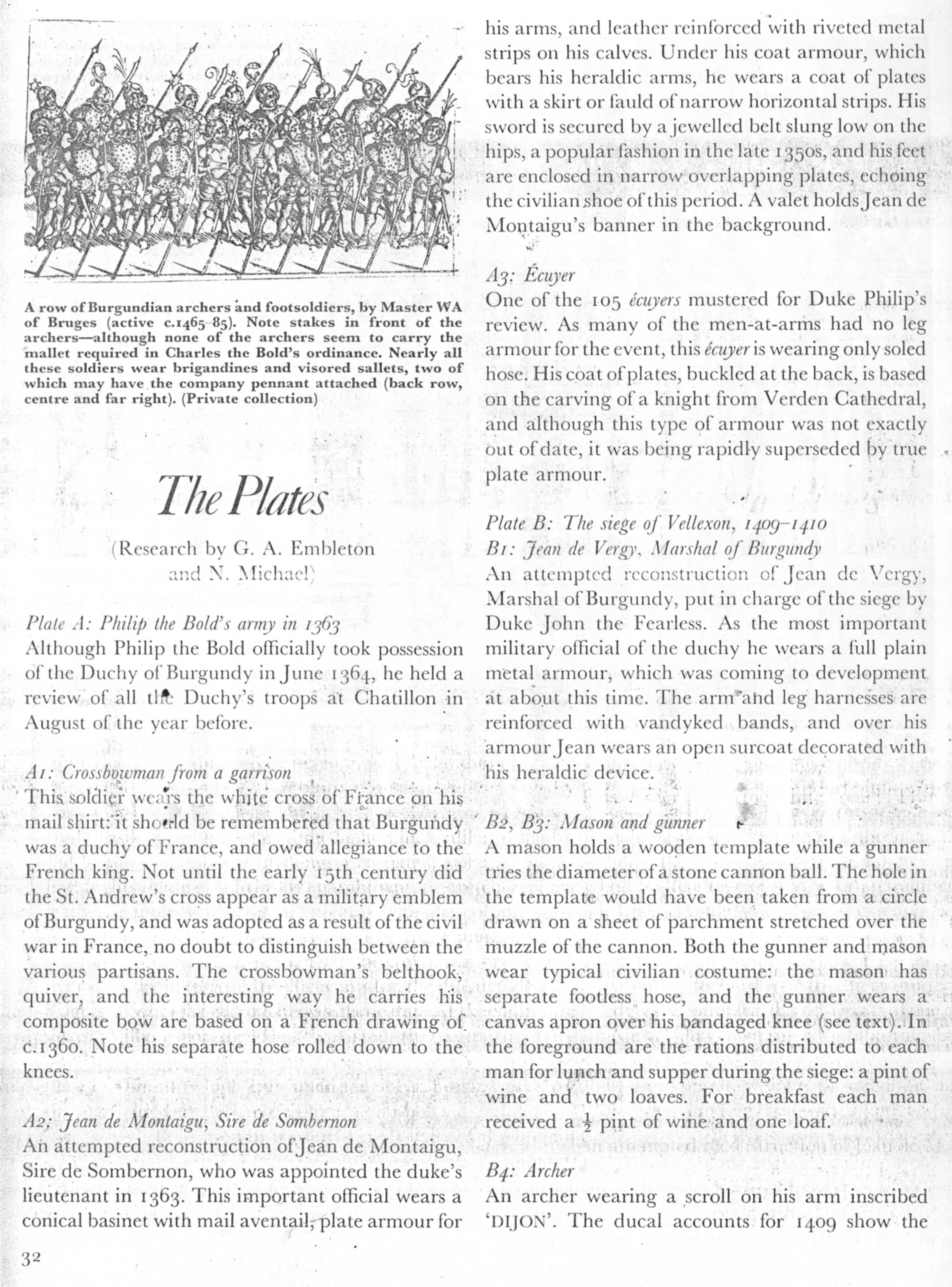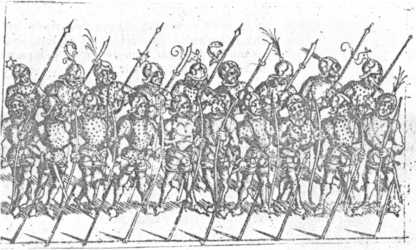22973 m1442


A row ofBurgundian archers and footsoldiers, by Master W A of Brugcs (active c.1465 85). Notę stakes in front of the archers—although nonę of the archers seem to carry the mallet required in Charles the Bold’s ordinance. Nearly all these soldiers wear brigandines and visored sallets, two of which may have the company pennant attached (back row, centre and far right). (Private collection)
The Pt'ates
(Research by G. A. Embleton
and X. Michac!)
Platę A: Philip the Bo/d’s army in 1363 Although Philip the Bold officially took possession of the Duchy of Burgundy in June 1364, he held a review of all lift.- Duchy’s troopś at Chatillon in August of the year before.
A1: Crossbowman from a garrison This soldiyr wears the wbite cross bf France on his mail shirt: it sh< *rld be remembered that Burgundy was a duchy of France, and owed allegiance to the French king. Not until the early ‘i5th century did the St. Andrew’s cross appear as a military cmblem of Burgundy, and was adopted as a result of the civil war in France, no doubt to distinguish between the various partisans. The crossbowman’s belthook, quiver, and the interesting way he carries his composite bow are based on a French drawing of c. 1360. Notę his separate hose rollecl down to the knees.
As: Jean de Monlaigu, Sire de Sombernon Aii attemptcd reconstruction ofjean de Montaigu, Sire de Sombernon, who was appointed the duke’s lieutenant in 1363. This important official wears a conical basinet with mail aventailr piąte armour for
his arms, and leathcr reinforcecł with riveted metal strips on his calves. Under his coat armour, which bcars his hcraldic arms, he wears a coat of plates with a skirt or fauld of narrow horizontal strips. His sword is secured by a jewellcd bclt slung Iow on the hips, a popular fashion in the late 1350S, and his fcet are enclosed in narrow ovcrlapping plates, echoing the civilianshoe ofthis period. A valct holdsjean de Montaigu’s banner in the background.
Aj: Ecuyer
One of the 105 ecuyers mustered for Duke Philip’s review. As many of the men-at-arms had no leg armour for the event, this ecuyer is wearing only soled hose. His coat of plates, buckled at the back, is based on the carving of a knight from Verden Cathedral, and although this type of armour was not exactly out ofdatc, it was being rapidly supcrseded by tnie piąte armour.
Platę B: The siege of Vellexon, 1403-1410 B/: Jean de Vergy, Marshal of Burgundy A11 attemptcd reconstruction ofjean dc Ycrgy, Marshal of Burgundy, put in charge of the siege by Duke John the Fearless. As the most important military ollicial of the duchy he wears a fuli plain metal armour, which was coming to dcvelopment at abo.ut this time. The arrrTahd leg harncsscs are reinforced with vandyked bands, and over his armour Jean wears an open surcoat decorated with his heraldic device.
’"ó ' ‘Sr'' - 0 * , * V
' Bs, Bj: Mason and gunner t-A mason holds a wooden template while a gunner tries the diameter ofa stonc cannon bali. The hole in the template would have been taken from a circle drawn on a sheet of parchment stretched over the muzzle of the cannon. Both the gunner and mason wear typical civilian costume: the mason has separate footless hose, and the gunner wears a canvas apron over his bandaged knee (see text). In the foreground are the rations distributed to each man for lunch and supper during the siege: a pint of winę and two loaves. For breakfast each man received a J pint of winę and one loaf.
B4: Archer
An archer wearing a scroll on his arm inscribed ‘DIJON’. The ducal accounts for 1409 show the
32
Wyszukiwarka
Podobne podstrony:
immediately blocked up and protected by means of 130 retaining walls of dry masonry and 79 carth tcr
Higher educationsystem in Poland economy; i master (MA, MSc, magister) and equivalent degrees: Maste
sa 22 F£xercise 20.— Hands and Forearms Let yoiir arms hang down holding a stick ver_v firndy in fro
img112 (18) incredible (and practically 360 degree) views. Wetook a walk up the field directly in fr
s&h 171 STREXGTH AND HEALTH 171 RBKATITING—No. 4 Drop tlie arms nntil tlio hands inect in front of t
62005 Ittman 27 PHYSICAL CULTURE AND BREATHING 27 Exercisc No. U. Stand ercct. Kaisc cacli leg alter
s&h 171 STREXGTH AND HEALTH 171 RBKATITING—No. 4 Drop tlie arms nntil tlio hands inect in front of t
image006 HAVE YOU SEENBeyondFANTASY FICTION? THE STARTLING NEW MAGAZINE DESIGNED, EDITH* AND PRODUCE
00136 ?b0b84f71f40695e8844499eae9e824 137 Optimization and Sensitivity Analysis verification of the
Mandalaband 4 5 IMANDALABANDThe Eye of Wendor: Prophecies Written and Produced by DaVid Rohl Enginee
więcej podobnych podstron